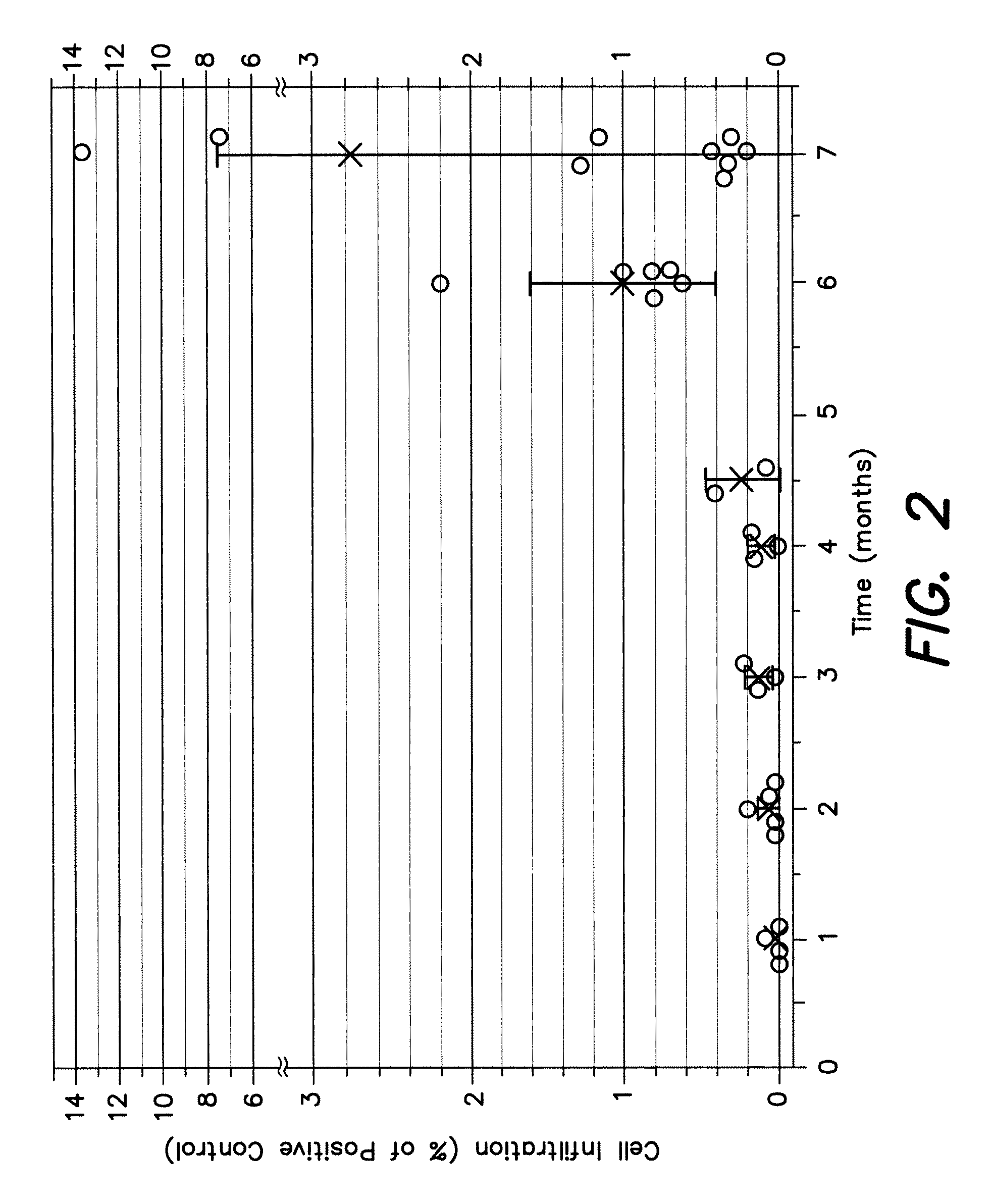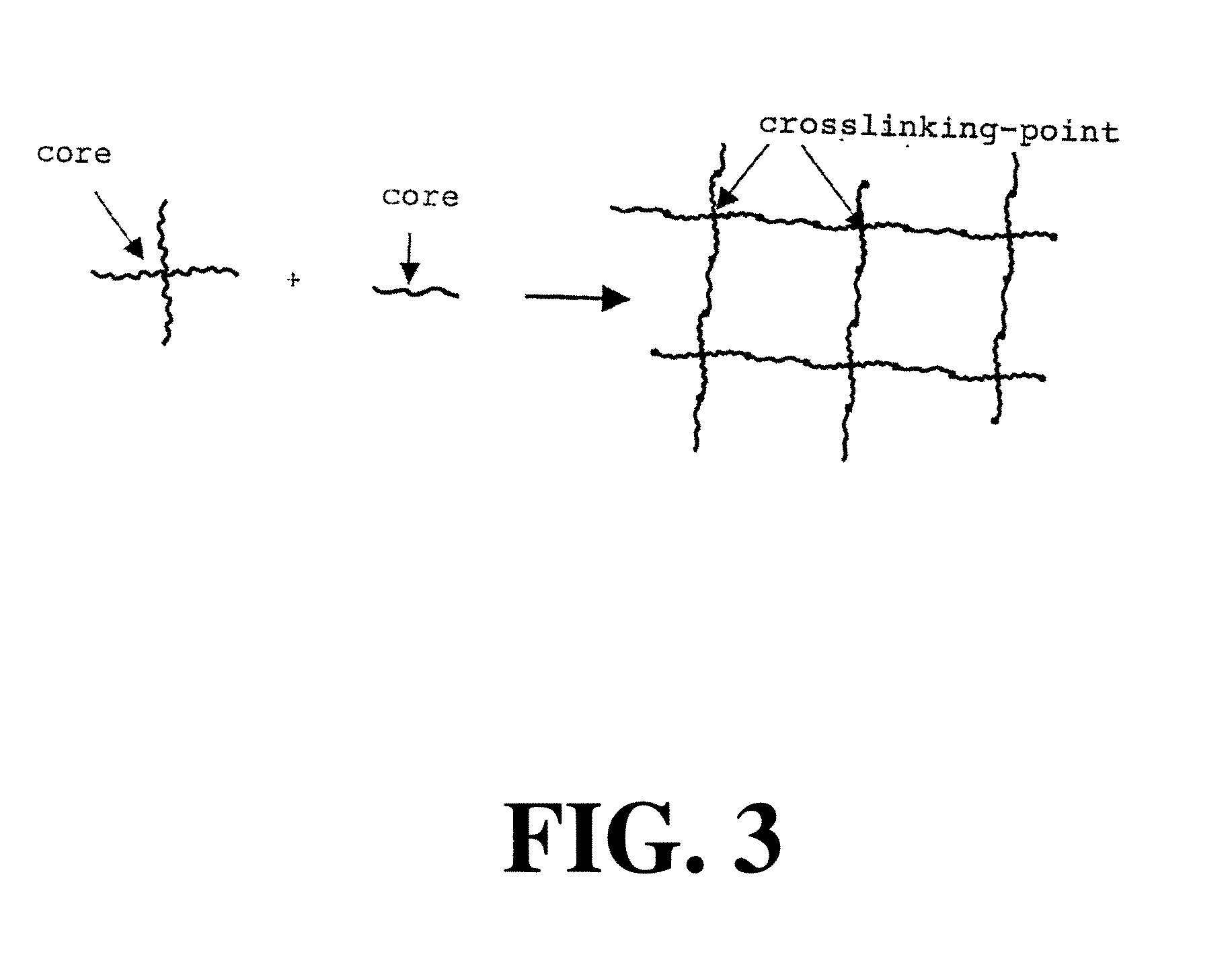Barrier membrane
a barrier membrane and cell technology, applied in the field of cellocclusive membranes, can solve the problems of xenogenic material always bearing the risk of infection, time-consuming, hampered function of such implants, etc., and achieve the effect of good stabilization
- Summary
- Abstract
- Description
- Claims
- Application Information
AI Technical Summary
Benefits of technology
Problems solved by technology
Method used
Image
Examples
example 1
PEG-tetrathiol 2 k
A.) PEG-tetraallylether 2 k
[0036]
[0037]20.3 g of 4-arm PEG 2 k (Mn=2323 g / mol, 35.7 meq OH) were dissolved in 200 ml of dry tetrahydrofuran under an Ar atmosphere. The solution was dried by refluxing the solvent over molecular sieves until the water content had fallen below 200 ppm. Then, it was allowed to cool down to room temperature and 2.69 g of a 60% NaH suspension in mineral oil (67 mmol) were added and allowed to react for 15 min, after which 8.75 g of allylbromide (73.3 mmol) were added. The suspension was brought to reflux and stirred overnight. After cooling down, it was filtered through ca. 1 cm of Celite 545, yielding a pale yellow, clear solution. Solvent and excess allylbromide were removed by rotary evaporation and the remaining oil was redissolved in 200 ml of water. Washing the resulting emulsion with three 50 ml portions of diethyl ether yielded a clear, pale yellow solution in which 20 g of NaCl were dissolved. The product was extracted with thre...
example 2
Linear PEG-dithiol 3.4 k
[0041]A.) α,ω-bis allyl-PEG
[0042]34.0 g of α,ω-bishydroxy-PEG (Mn=3391 g / mol, 20.1 meq OH) were dissolved in 250 ml of dry tetrahydrofuran under an Ar atmosphere. The solution was dried by refluxing the solvent over molecular sieves until the water content had fallen below 100 ppm. Then it was allowed to cool down to ca. 50° C. and 1.68 g of a 60% NaH suspension in mineral oil (42 mmol) were added and allowed to react for 15 min, after which 4.0 ml allylbromide (47 mmol) were added. The suspension was brought to reflux and stirred overnight. After cooling down, it was filtered through ca. 1 cm of Celite 545, yielding a pale yellow, clear solution. Solvent and excess allylbromide were removed by rotary evaporation and the resulting solid was redissolved in 200 ml of water. Washing the resulting emulsion with two 50 ml portions of diethyl ether yielded a clear, pale yellow solution in which 20 g of NaCl were dissolved. The product was extracted with three 50 ml...
example 3
PEG-tetraacrylate 2 k
[0045]
[0046]12.7 g of 4-arm PEG 2 k (Mn=2323 g / mol, 21.9 meq OH) were dissolved in 250 ml of dry tetrahydrofuran under an Ar atmosphere. The solution was dried by refluxing the solvent over molecular sieves until the water content had fallen below 100 ppm, after which it was allowed to cool down to room temperature. 2.81 g of triethylamine (27.8 mmol) were added and a solution of 2.51 g of acryloylchloride (27.7 mmol) in 25 ml of dry dichloromethane was added drop wise at such a rate that the temperature of the reaction mixture remained below 30° C. The resulting suspension was filtered through ca. 1.5 cm of Celite 545, yielding a pale yellow, clear solution to which 44 mg of MEHQ were added. The solvent was removed by rotary evaporation, the remaining oil was redissolved in 150 ml of water and NaHCO3 was added until pH 8. The aqueous solution was washed three times with 50 ml of diethyl ether, 15 g of NaCl were added and the product was extracted with five 50 m...
PUM
| Property | Measurement | Unit |
|---|---|---|
| temperature | aaaaa | aaaaa |
| pH | aaaaa | aaaaa |
| frequency | aaaaa | aaaaa |
Abstract
Description
Claims
Application Information
 Login to View More
Login to View More - R&D
- Intellectual Property
- Life Sciences
- Materials
- Tech Scout
- Unparalleled Data Quality
- Higher Quality Content
- 60% Fewer Hallucinations
Browse by: Latest US Patents, China's latest patents, Technical Efficacy Thesaurus, Application Domain, Technology Topic, Popular Technical Reports.
© 2025 PatSnap. All rights reserved.Legal|Privacy policy|Modern Slavery Act Transparency Statement|Sitemap|About US| Contact US: help@patsnap.com



